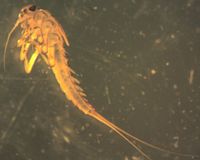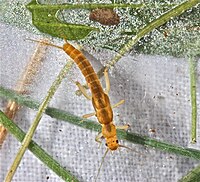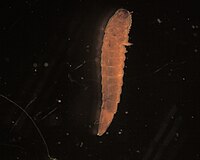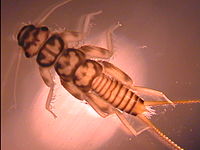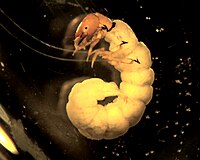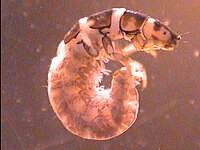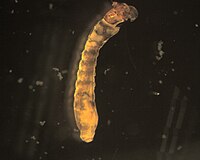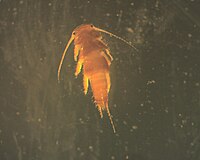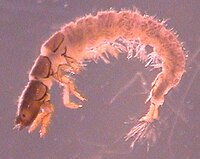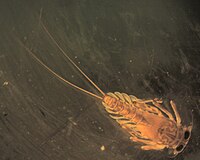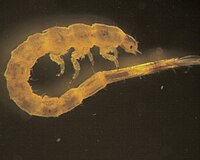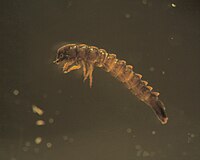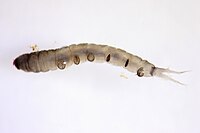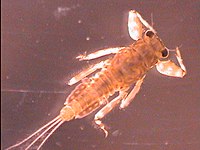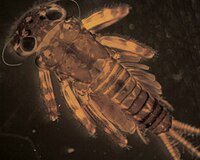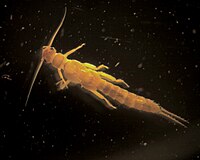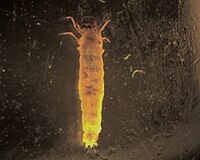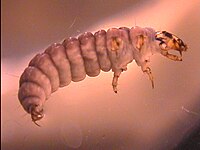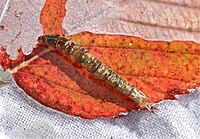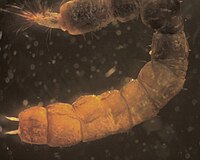Vermont EPSCoR's Streams Project; A Teacher Collaboration on WikiEducator
Openly shared content, practices, and developing resources from Vermont EPSCoR's Streams Project. Join this collaboration and make a difference!
 Halls Brook |
|---|
|
| Stream code: | CTJW_HllsBrk_713 |
| Basin: | Waits River |
| State or Province: | Vermont |
| Country: | USA |
| Latitude: | 44.06445 |
| Longitude: | -72.11192 |
| School: | Oxbow High School |
The following are the most common invertebrates collected from this stream site.
Baetis
- Order
- Ephemeroptera
- Family
- Baetidae
- Genus
- Baetis
- Common name
- The Little Olive
- Tied fly
- Sawyer Pheasant Tail Nymph
This mayfly has three "tails" and a unique head shape. Its gills are oval shaped and insert dorsally. More mature nymphs have long, dark wing pads.
Image of the long, dark wing pads.
Chironomidae
- Order
- Diptera
- Family
- Chironomidae
- Common name
- Nonbiting midge
- Tied fly
- Griffith's Gnat
Midge larvae tend to be the most common macroinvertebrate at our sites. As with other Diptera, there are no true jointed legs. Chironomidae do have a pair of prolegs at each end and preserved individuals tend to curl into a 'C'. Identification past family requires slide-mounted heads. We have seen philopotamid caddisflies misidentified with the chironomids and we suspect that that happens when samples are being sorted from trays. Under a microscope, six prominent legs can be seen on members of the caddisfly family Philopotamidae.
More information on Philopotamidae.
Leuctra
- Order
- Plecoptera
- Family
- Leuctridae
- Genus
- Leuctra
This family of stonefly is fairly slender by stonefly standards. The divergent wing pads are a helpful characteristic. Leuctridae are similar in overall shape to the Capniidae; however, Leuctridae often do not have pleural folds. If they are present, they only extend from abdominal segments 1-7.
Leuctra are recognized by abdominal terga with posterior fringes of short hairs and last few segments with longer hairs.
Image of the divergent wing pads.
Optioservus
- Order
- Coleoptera
- Family
- Elmidae
- Genus
- Optioservus
The larvae of
Optioservus have open coxae, as determined by the straight definition between segments on the ventral side of the pronotum.
The adult Optioservus have a compact appearance, especially the head and thorax. There are also dorsal ridges and a characteristic diamond-shaped sutellum observable in the dorsal view.
Images of the straight definition between segments, the dorsal ridgesand the diamond-shaped scutellum.
Agnetina
- Order
- Plecoptera
- Family
- Perlidae
- Genus
- Agnetina
Agnetina nymphs have cylindrical, striped abdomens. Like other Plecoptera, they have 2 tails and 2 claws on each tarsus. This genus has three black dots (ocelli) on the top of the head. Click to see the
three ocelli on the dorsum of the head (3 black dots at joint with the pronotum). This stonefly is characterized by the
filamentous gills located in the "armpits". Another important feature is the paraglossae and glossae extending different lengths. The
occiput has a transverse row of evenly spaced little hairs.
Agnetina has another row of evenly spaced hairs on the posterior edge of
abdominal segment 7.
Dolophilodes
- Order
- Trichoptera
- Family
- Philopotamidae
- Genus
- Dolophilodes
Hydropsychidae
- Order
- Trichoptera (caddisfly)
- Family
- Hydropsychidae
- Common name
- net spinning caddisfly
- Tied fly
- Emergent Sparkle Pupa, Vermont Hare's Ear
This family of net-spinning caddisflies is very abundant at several sites. They are important filtering collectors and are quite common at urban and agricultural sites where particles of organic material can be important food resources. Genus-level identification is possible for mature specimens and we will include the genera we found at your site if possible.
When using the key, some features that are challenging to see are the forked trochantin and the paired sclerites in the folds between segments. Other, more easily seen key features include filamentous gills on the abdominal segments and the sclerotization of the dorsal surfaces of all three thoracic segments. Keep in mind that with smaller or more immature specimens, genus-level ID may not be possible.
Commonly found genera include Cheumatopsyche, Ceratopsyche, and Hydropsyche. Less commonly, we have found Arctopsyche and Potamyia.
Images of the forked trochantin and the paired sclerites.
Ceratopsyche
- Order
- Trichoptera
- Family
- Hydropsychidae
- Genus
- Ceratopsyche
Ceratopsyche has a
forked foretrochantin. The foretrochantin is the projection at the uppermost portion of the foreleg. The leg may need to be pulled away from the body to expose this feature.
Ceratopsyche have a
large pair of sclerites underneath the prosternum. Note: the large single sclerite is the prosternal plate. Biologists have gone back and forth between lumping this genus into
Hydropsyche and splitting it back out. ITIS currently lists it as a genus (Feb 2013) but we are aware of a recent paper that lumped it under
Hydropsyche.
Simuliidae
- Order
- Diptera
- Family
- Simuliidae
Simuliidae appear rather like bowling pins with heads. Relatively speaking, we collect few members of this family and have we have not identified them past family at this point.
Click here for a close up image of the heads.
Peltoperlidae
- Order
- Plecoptera
- Family
- Peltoperlidae
- Common name
- The Little Roach-like Stonefly
- Tied fly
- Yellow Humpy
Peltoperlidae have stout, roach-like bodies and can have conical gills at the base of legs. Ventral overlapping plates are found on their large thorax. They have a single gill on each side posterior to thoracic segment 3. Peltoperlidae is not covered in the family-level key (Bouchard 2006) used by the Streams Project.
Image of the single gill on each side posterior to thoracic segment 3.
Cheumatopsyche
- Order
- Trichoptera
- Family
- Hydropsychidae
- Genus
- Cheumatopsyche
Cheumatopsyche has a
forked foretrochantin (as does
Ceratopsyche). The foretrochantin is the projection at the uppermost portion of the front leg closest to the head. The leg may need to be pulled away from the body to expose this feature.
Cheumatopsyche have a small or inconspicuous
pair of sclerites under the prosternal plate that are difficult to see. Contrast that with the
larger pair of sclerites found on Ceratopsyche. To access sclerites, it's best to gently pull the pronotum and mesonotum in opposite directions. Note: the large single sclerite is the prosternal plate.
Cheumatopsyche have only 2 types of
hair on the abdomen: long thin plain hairs and thicker club hairs, which are narrow close to the body and widen out at the distal end. Paired sclerites on the ninth abdominal segment are notched.
Epeorus
- Order
- Ephemeroptera
- Family
- Heptageniidae
- Genus
- Epeorus
- Common name
- The Quill Gordon
- Tied fly
- Quill Gordon
This is the only Heptageniidae genus present in this area with two tails!
Dubiraphia
- Order
- Coleoptera
- Family
- Elmidae
- Genus
- Dubiraphia
The larvae of this genus are distinguished by the last abdominal segment, which is very elongated. Adults of this genus usually have prominent longitudinal markings on their elytra and, like adult
Optioservus, have a fringe of tomentum on their anterior tibia.
Image of the fringe of tomentum.
Promoresia
- Order
- Coleoptera
- Family
- Elmidae
- Genus
- Promoresia
So far we have only encountered Promoresia larvae; as soon as an adult becomes available to us, this template will be revised! The defining characteristic of the larvae is the prominent ridge along the back of the abdomen.
Antocha
- Order
- Diptera
- Family
- Tipulidae
- Genus
- Antocha
This small dipteran in the cranefly family is quite common. It is distinguished from most other dipterans we found by the 'creeping welts' that appear as prominent dark stripes along the abdomen. The dark head is usually partly exposed; however, it can be pulled back into the thoracic cavity during preservation.
Ephemerellidae
- Order
- Ephemeroptera
- Family
- Ephemerellidae
- Common name
- spiny crawler mayflies
- Tied fly
- Blue-Winged Olive
The mayfly
Ephemerellidae is distinguished by the absence of gills on the second abdominal segment; individuals either have gills on segments 3-7 or 4-7. Some may have operculate (plate-like) gills on the fourth segment, though in many the gills are of identical size. The most commonly found genera include
Drunella,
Ephemerella, and
Serratella.
More information on the genera Drunella, Ephemerella, and Serratella.
Maccaffertium
- Order
- Ephemeroptera
- Family
- Heptageniidae
- Genus
- Maccaffertium
- Common name
- The March Brown
- Tied fly
- March Brown
This genus of
Heptageniidae is distinguished by its gills on the seventh abdominal segment, which are reduced to slender filaments. Gills on segments 1-6 are truncated.
Images of the slender filaments, and the truncated gills.
Chloroperlidae
- Order
- Plecoptera
- Family
- Chloroperlidae
- Common name
- The Yellow Sally
- Tied fly
- Yellow Sally
Stoneflies from the family Chloroperlidae have cylindrical banded abdomens. When observing their mouthparts, the glossae and paraglossae form a three-pronged (open) notch, and their hind wing pads are parallel (not divergent). Cerci have a vertical fringe of hairs pointing away from the abdomen. Setae on the pronotum are found primarily at the corners.
Lepidostomatidae
- Order
- Trichoptera
- Family
- Lepidostomatidae
- Common name
- The Little Plain Brown Sedge
- Tied fly
- Elk Hair Caddis
These have lateral humps on the first abdominal segments, but lack a dorsal hump. The dorsal of the first two thoracic segments are sclerotized. They are frequently found in four-sided cases made of square pieces of detritus.
Images of the first two thoracic segments and the four-sided cases.
Rhyacophila
- Order
- Trichoptera
- Family
- Rhyacophilidae
- Genus
- Rhyacophila
- Common name
- Green Caddis
- Tied fly
- Henryville Special or Glass Bead Caddis
In our lab,
Rhyacophila is known as the "Michelin Man" due to its large banded body. It has a very obviously checker-patterned head. It also has terrifying anal claws with large accessory hooks.
Links to images that may be useful if you have a magnifying glass or microscope:
Checker-patterned head.
Anal claws with large accessory hooks.
Hexatoma
- Order
- Diptera
- Family
- Tipulidae
- Genus
- Hexatoma
This Tipulidae can be identified by the swollen 7th abdominal segment. The swelling is bulbous and frequently as much as 2X abdominal diameter in preserved specimens.
Limnophila
- Order
- Diptera
- Family
- Tipulidae
- Genus
- Limnophila
This genus of
Tipulidae has a spiracular disk with 4 lobes fringed with long hair. Out of the other end, simple, non-jointed mandible project even when the head is retracted (pictured in the lower left area of the main image). The head, which can be viewed by cutting away the skin, is not extensively sclerotized. Rather, the sclerites are long, slender rods.
Image of the head.

